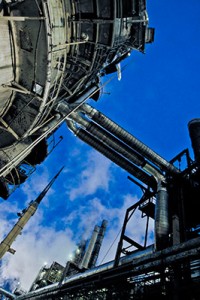Problems with mercaptan formation, particularly with naphtha hydrotreating at very low sulfur levels have been studied in detail by Advanced Refining Technologies LLC (ART). In this endeavor research carried out by Dr. David Krenzke, ART Regional Manager of Hydrotreating Technical Services had the following detailed elaboration on the matter:
Mercaptan formation with naphtha hydrotreating at very low sulfur levels occurs due to the recombination reaction between olefins and H2S. Even though H2 partial pressure may be relatively high, there is always an equilibrium between the paraffin and the olefin. While the select hydrotreating catalyst in use may be a good hydrogenation catalyst, all hydrogenation catalysts are also good dehydrogenation catalyst as well! This is why there will always exist an equilibrium of partial pressure olefins, which can lead to mercaptan formation (depending on H2S concentration). The reaction is favored by:
- High temperature and low, relatively constant H2 pressure (i.e., end-of-run [EOR] conditions at bottom of naphtha hydrotreating reactor). As cycle continues and catalyst slowly deactivates, the olefins concentration increases with increasing temperature, generating measurable quantities of mercaptans
- High H2S concentrations will also favor mercaptan formation if sulfur concentration in feed is relatively high
- Processing cracked feedstocks (e.g., VB/coker naphtha) negatively impacts H2 partial pressure at the bottom of the reactor because these cracked materials consume excess hydrogen while also generating relatively large exotherms in saturating the olefins, essentially, reducing e hydrogen pressure and increase temperature at reactor outlet.
In a mercaptan recombination case study where SR naphtha was processed at 8.0 LHSV, 410 psig and 400 scfb H2/oil ratio, 0.5 ppm sulfur target was not met because reactor temperature was set higher than the proposed SOR temperature of 600 °F.
At this point, it should be mentioned that in most cases, the refiner doesn’t operate the naphtha hydrotreater in the same mode as the FCC pretreater or ULSD units, where there is daily feed and product analysis and temperature is constantly controlled to maintain product sulfur target levels. In many cases, the refiner will select and maintain a naphtha hydrotreater temperature where they estimate a product sulfur specification of less than 0.5 ppm can be met.
It has been ART’s experience that the refiner will then not “bother” looking at daily product analytical data until they encounter an operational issue with the naphtha reformer. They will then begin to review the analytical data to perform the required temperature adjustment. Therefore, this is not an uncommon scenario that the refiner selects a temperature and just sets it there.
In this case, the refiner further increased temperature when the 0.5 ppm sulfur target was not being met, resulting in even higher sulfur levels (i.e., from about 0.6 ppm S to 1.2 ppm S between 610 and 630 °F, respectively). This indicated to ART that the unit was encountering recombination reactions and a reduction in inlet temperature to the proposed 600 °F or below was recommended. Sulfur levels then decreased well below 0.5 ppm while also eliminating recombination reactions and mercaptans generation.
Editor’s note: Refinery Operations extends its appreciation to Advanced Refining Technologies (ART) and Grace Davison for supplying this information on hydrotreater performance guidelines. For further elaboration, the reader should contact Woody Shiflett, Ph.D., Ch.E, Director of Global Marketing at ART (wosh@chevron.com; +1 1510 242 1166).








Leave a Reply
You must be logged in to post a comment.